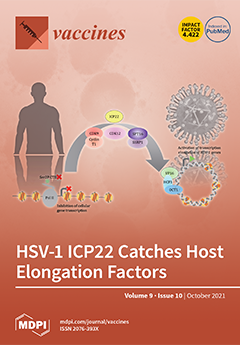Open AccessArticle
Avian Cell Line DuckCelt®-T17 Is an Efficient Production System for Live-Attenuated Human Metapneumovirus Vaccine Candidate Metavac®
by
Caroline Chupin, Andrés Pizzorno, Aurélien Traversier, Pauline Brun, Daniela Ogonczyk-Makowska, Blandine Padey, Cédrine Milesi, Victoria Dulière, Emilie Laurent, Thomas Julien, Marie Galloux, Bruno Lina, Jean-François Eléouët, Karen Moreau, Marie-Eve Hamelin, Olivier Terrier, Guy Boivin, Julia Dubois and Manuel Rosa-Calatrava
Cited by 5 | Viewed by 3401
Abstract
The development of a live-attenuated vaccine (LAV) for the prevention of human metapneumovirus (HMPV) infection is often hampered by the lack of highly efficient and scalable cell-based production systems that support eventual global vaccine production. Avian cell lines cultivated in suspension compete with
[...] Read more.
The development of a live-attenuated vaccine (LAV) for the prevention of human metapneumovirus (HMPV) infection is often hampered by the lack of highly efficient and scalable cell-based production systems that support eventual global vaccine production. Avian cell lines cultivated in suspension compete with traditional cell platforms used for viral vaccine manufacture. We investigated whether the DuckCelt
®-T17 avian cell line (Vaxxel), previously described as an efficient production system for several influenza strains, could also be used to produce a new HMPV LAV candidate (Metavac
®, SH gene-deleted A1/C-85473 HMPV). To that end, we characterized the operational parameters of MOI, cell density, and trypsin addition to achieve the optimal production of Metavac
®, and demonstrated that the DuckCelt
®-T17 cell line is permissive and well-adapted to the production of the wild-type A1/C-85473 HMPV and the Metavac
® vaccine candidate. Moreover, our results confirmed that the LAV candidate produced in DuckCelt
®-T17 cells conserves its advantageous replication properties in LLC-MK2 and 3D-reconstituted human airway epithelium models, and its capacity to induce efficient neutralizing antibodies in a BALB/c mouse model. Our results suggest that the DuckCelt
®-T17 avian cell line is a very promising platform for the scalable in-suspension serum-free production of the HMPV-based LAV candidate Metavac
®.
Full article
►▼
Show Figures






